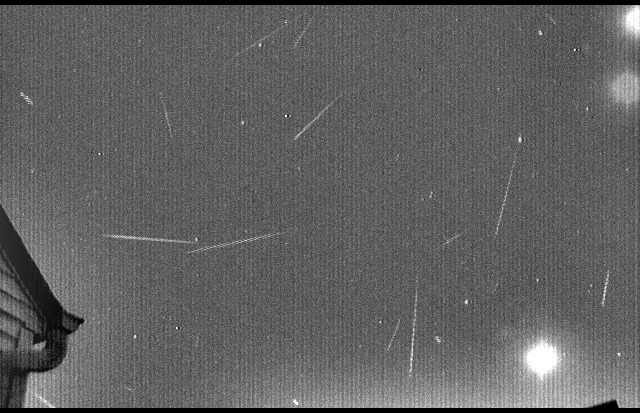
During the next couple of weeks, there is a fairly good chance that Earth will encounter a swarm of unusually large space particles, capable of generating some eye-catching fireball meteors.
The Taurid meteors, sometimes called "Halloween fireballs,"(fireballs are extremely bright meteors) create one of this year's longest meteor showers, with at least a couple of shooting stars per hour from Oct. 20 to Nov. 30. But a one-week time frame extending from Nov. 5 through Nov. 12 is when the Taurids are most active.
During peak times, about a dozen or so meteors may be seen per hour by an observer with clear, dark skies. (City lights or even slight haze will reduce substantially the number of faint meteors seen.) These meteors are often yellowish-orange and, as meteors go, appear to move rather slowly. [Skywatching in 2015: 9 Must-See Stargazing Events]
Meteors — popularly known as "shooting stars" — are produced when debris enters and burns up in Earth's atmosphere. The meteors that make up the Taurid meteor shower are attributed to debris left behind by Encke's Comet, or perhaps by a much larger comet that upon disintegrating, left Encke and a lot of other rubble in its wake. Indeed, the Taurid debris stream contains noticeably larger fragments than those shed by other comets, which is why in certain years — and 2015 is predicted to be one — this rather elderly meteor stream occasionally delivers a few unusually bright meteors.
Two streams for the price of one
The Taurids are actually divided into the Northern Taurids and the Southern Taurids. This is an example of what happens to a meteor stream when it grows old. The particles in the stream, even when they were first formed, could not have been moving in exactly the same orbit as their parent comet, and their slight divergence accumulates with time. The sun is not the only body gravitationally controlling the particles' orbits — the planets also have a subtle effects on the stream. Because the positions of the planets relative to the sun are constantly changing, the particles pass nearer to them on some revolutions than others — diverting parts of the stream, fanning it out and splitting it. So what was originally one stream diffuses into a cloud of minor streams and isolated particles in individual orbits, crossing Earth's orbit at yet more widely scattered times of the year and coming from more scattered directions until they are entirely stirred into the solar system's general haze of dust.
The radiant or apparent radiant of a meteor shower is the point in the sky from which meteors appear to originate. But as I just noted, the Taurid radiant is split into two, with the southern radiant most active on Nov. 5 and the northern radiant most active on Nov. 12. Both cross the southern meridian and are highest in the sky about midnight. The two radiants lie just south of the Pleiades — a cluster of stars in the constellation Taurus. So during the next couple of weeks, if you see a bright, slightly orange-tinted meteor sliding rather lazily away from that famous little smudge of stars, you can feel sure it is a Taurid.
A fireball year?
Another reason 2015 will be an excellent year for the Taurids is the very favorable situation regarding the moon. On the morning of Nov. 5, it will be a fat waning crescent in the constellation Leo and will not rise until after 12:30 a.m. local time, causing only a minor hindrance to meteor watchers. It will then get progressively thinner and rise progressively later on successive mornings, until finally it will arrive at a new phase on Nov. 11, leaving the entire night dark and moonless for meteor watchers.
Get the Space.com Newsletter
Breaking space news, the latest updates on rocket launches, skywatching events and more!
Encke has the shortest-known orbital period for a comet, taking only 3.3 years to make one complete trip around the sun. Meteor expert David Asher discovered that the Earth can periodically encounter swarms of larger particles shed by this comet in certain years and lo and behold, 2015 is predicted to be one of those years. Check this link for more information.
The year 2005 was also an exceptional swarm year. Many stupendously bright meteors were seen, especially along the U.S. East Coast on Halloween evening, when fireballs as bright as the full moon were witnessed.
Will 2015 offer a repeat performance? Only by going out and watching for these colorful and slow-moving meteors will we know for sure.
Joe Rao serves as an instructor and guest lecturer at New York's Hayden Planetarium. He writes about astronomy for Natural History magazine, the Farmer's Almanac and other publications, and he is also an on-camera meteorologist for News 12 Westchester, N.Y. Follow us @Spacedotcom, Facebook or Google+. Originally published on Space.com.
Join our Space Forums to keep talking space on the latest missions, night sky and more! And if you have a news tip, correction or comment, let us know at: community@space.com.

Joe Rao is Space.com's skywatching columnist, as well as a veteran meteorologist and eclipse chaser who also serves as an instructor and guest lecturer at New York's Hayden Planetarium. He writes about astronomy for Natural History magazine, the Farmers' Almanac and other publications. Joe is an 8-time Emmy-nominated meteorologist who served the Putnam Valley region of New York for over 21 years. You can find him on Twitter and YouTube tracking lunar and solar eclipses, meteor showers and more. To find out Joe's latest project, visit him on Twitter.